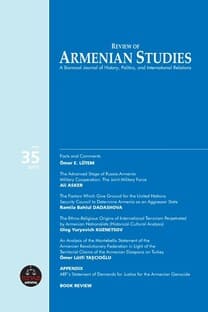KAÇIRILAN FIRSAT: HAMİDİYE POLİSİNİN ERMENİ DEVRİMCİLERİNE KARŞI BAŞARILARI, 1905-1908
THE MISSED OCCASION: SUCCESSES OF THE HAMIDIAN POLICE AGAINST THE ARMENIAN REVOLUTIONARIES, 1905-1908
___
« Le nouveau gouverneur de Van », Le Temps, 13 août 1915, p. 3, http://gallica.bnf.fr/ark:/12148/bpt6k2422643/f2.zoom.langFR Antoine Constant, L’Azerbaïdjan, Paris : Karthala, 2002.Dikran Mersop Kaligian, Armenian Organization and Ideology under the Ottoman Rule, 1908-1914, New Brunswick (NJ): Transaction Publishers, 2009.
Donald Quataert, The Ottoman Empire, 1700-1922, New York-Cambridge: Cambridge University Press, 2005.
E. Aknouni Political Persecution, Armenian prisoners of the Caucasus, New York, 1911.
Edward J. Erickson, Ottomans and Armenians. A Study in Counterinsurgency, New York-London, Palgrave MacMillan, 2013.
François Georgeon, Abdülhamid II : le sultan calife (1876-1909), Paris: Fayard, 2003.
Gaïdz Minassian, Géopolitique de l’Arménie, Paris, Ellipses, 2005. Gaïdz Minassian, Guerre et terrorisme arméniens, Paris : Presses universitaires de France, 2002.
Guenter Lewy, The Armenian Massacres in Ottoman Turkey, Salt Lake City: University of Utah Press, 2005.
Hratch Dasnabedian, History of the Armenian Revolutionary Federation Dashaktsutiun, 1890/1924, Milan: Oemme, 1989.
İnayetullah Cemal Özkaya, Le Peuple arménien et les tentatives de réduire le peuple turc en servitude, İstanbul, Belgelerle Türk Tarih Dergisi, 1971.
Jacques Derogy, Resistance and Revenge: The Armenian Assassination of Turkish Leaders Responsible for the 1915 Massacres and Deportations, Rutgers (NJ): Transaction Publishers, 1990.
Justin McCarthy, Esat Arslan, Cemalettin Taşkıran and Ömer Turan, The Armenian Rebellion at Van, Salt Lake City: University of Utah Press, 2006. Kâmuran Gürün, The Armenian File: the Myth of Innocence Exposed, NicosiaLondon: K. Rüstem & Brothers/Weidenfeld & Nicolson, 1985.
Kapriel Serope Papazian, Patriotism Perverted, Boston: Baikar Press, 1934. Kemal Çiçek, (ed.), 1909 Adana Olayları Makaleler/The Adana Incidents of 1909 Revisited, Ankara, TTK, 2011.
Leon Z. Surmelian, I Ask You, Ladies and Gentlemen, New York: E. P. Dutton, 1945.
Louise Nalbandian, The Armenian Revolutionary Movement, Berkeley-Los Angeles-London: University of California Press, 1963.
Mikael Varandian, Rapport présenté au congrès socialiste international de Copenhague par le parti arménien « Daschnaktzoutioun ». Turquie — Caucase — Perse, Genève, 1910.
Pierre Milza, Voyage en Ritalie, Paris : Payot, 2004.
Salâhi R. Sonyel, Minorities and the Destruction of the Ottoman Empire, Ankara: TTK, 1993.
Salâhi Sonyel, “The Turco-Armenian ‘Adana Incidents’ in the Light of Secret British Documents (July 1908-December 1909),” Belleten, LI/201, 1987, pp. 381-449, http://www.ttk.gov.tr/templates/resimler/File/fulltext/Belleten_ Makale/bel201-1291_1338.pdf
Sidney Whitman, Turkish Memories, New York-London: Charles Schribner’s Sons/William Heinemann, 1914.
William L. Langer, The Diplomacy of Imperialism, 1890-1902, New York: Alfred A. Knopf, 1960.
Yücel Güçlü, The Holocaust and the Armenian Case in Comparative Perspective, Lanham-Boulder-Toronto-Plymouth: University Press of America, 2012.
- ISSN: 1303-5304
- Yayın Aralığı: 2
- Başlangıç: 2002
- Yayıncı: Terazi Yayıncılık Basım Dağıtım Danışmanlık Eğitim Organizasyon Matbaacılık Kırtasiye Tic. Ltd. Şti.
Great Catastrophe: Armenians and Turks in the Shadow of Genocide
(GEÇMİŞTEN GÜNÜMÜZE TÜRK-ERMENI BELLEK AÇMAZINDA KOLLEKTIF HAFIZA VE ANLATI ARAÇSALLIĞI)
Armenian History and the Question of Genocide
KAÇIRILAN FIRSAT: HAMİDİYE POLİSİNİN ERMENİ DEVRİMCİLERİNE KARŞI BAŞARILARI, 1905-1908)
KAÇIRILAN FIRSAT: HAMİDİYE POLİSİNİN ERMENİ DEVRİMCİLERİNE KARŞI BAŞARILARI, 1905-1908
